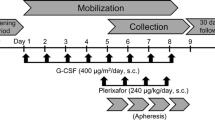Abstract
Introduction
Lenalidomide (LEN) is a relatively new and very effective therapy for multiple myeloma (MM). Prior LEN therapy is associated with an increased risk of peripheral blood stem cell collection (PBSC) failure, particularly with filgrastim (G-CSF) alone. We performed a retrospective chart review of 319 consecutive MM patients who underwent apheresis to collect PBSCs for the first autologous stem cell transplant (ASCT).
Results
The median number of PBSCs collected in the LEN (+) group was significantly less than the LEN (−) group (6.34 vs. 7.52 × 106 CD34+ cells/kg; p = 0.0004). In addition, the median number of apheresis sessions required for adequate PBSCs collection were significantly more in the LEN (+) group as compared to LEN (−) group (2 vs. 1 sessions; p = 0.002). In the LEN (+) group, there was a negative correlation between PBSCs collected and prior number of cycles of LEN (p = 0.0001). Rate of PBSC collection failure was 9 % in the LEN (+) group and 5 % in the LEN (−) group (p = 0.16). Only six patients who failed PBSC collection with G-CSF were able to collect adequate PBSCs with G-CSF + plerixafor. LEN exposure had no effect on neutrophil or platelet recovery post-ASCT.
Conclusions
Up to four cycles of LEN exposure have minimal negative impact on PBSC collection. Despite prolong exposure of LEN, PBSC collection was adequate for two ASCTs in the majority of patients and post-ASCT engraftment was not longer than expected; however, clinical relevance (complication rate, quality of life, cost) of prolonged LEN exposure on both PBSC and ASCT, should be evaluated in prospective clinical trials.

Similar content being viewed by others
References
Zonder JA, Crowley J, Hussein MA et al (2010) Lenalidomide and high-dose dexamethasone compared with dexamethasone as initial therapy for multiple myeloma: a randomized Southwest Oncology Group trial (S0232). Blood 116(26):5838–5841
Rajkumar SV, Jacobus S, Callander NS et al (2010) Lenalidomide plus high-dose dexamethasone versus lenalidomide plus low-dose dexamethasone as initial therapy for newly diagnosed multiple myeloma: an open-label randomised controlled trial. Lancet Oncol 11(1):29–37
Dimopoulos M, Spencer A, Attal M et al (2007) Lenalidomide plus dexamethasone for relapsed or refractory multiple myeloma. N Engl J Med 357:2123–2132
Kumar S, Dispenzieri A, Lacy MQ et al (2007) Impact of lenalidomide therapy on stem cell mobilization and engraftment post-peripheral blood stem cell transplantation in patients with newly diagnosed myeloma. Leukemia 21:2035–2042
Popat U, Saliba R, Thandi R et al (2009) Impairment of filgrastim induced stem cell mobilization after prior lenalidomide in patients with multiple myeloma. Biol Blood Marrow Transplant 15:718–723
Attal M, Harousseau JL, Stoppa AM et al (1996) A prospective, randomized trial of autologous bone marrow transplantation and chemotherapy in multiple myeloma. N Engl J Med 335:91–97
Child JA, Morgan GJ, Davies FE et al (2003) High-dose chemotherapy with hematopoietic stem-cell rescue for multiple myeloma. N Engl J Med 348(19):1875–1883
Bensinger W, Appelbaum F, Rowley S et al (1995) Factors that influence collection and engraftment of autologous peripheral-blood stem cells. J Clin Oncol 13(10):2547–2555
Tricot G, Jagannath S, Vesole D et al (1995) Peripheral blood stem cell transplants for multiple myeloma: identification of favorable variables for rapid engraftment in 225 patients. Blood 85(2):588–596
Gianni M, Alessandro S, Siena M et al (1989) Granulocyte-macrophage colony-stimulating factor to harvest circulating haematopoietic stem cells for autotransplantation. Lancet 334(8663):580–585
Mark T, Stern J, Furst JR et al (2008) Stem cell mobilization with cyclophosphamide overcomes the suppressive effect of lenalidomide therapy on stem cell collection in multiple myeloma. Biol Blood Marrow Transplant 14:795–798
DiPersio JF, Stadtmauer EA, Nademanee A et al (2009) Plerixafor and G-CSF versus placebo and G-CSF to mobilize hematopoietic stem cells for autologous stem cell transplantation in patients with multiple myeloma. Blood 113(23):5720–5726
Malard F, Kröger N, Gabriel IH et al (2012) Plerixafor for autologous peripheral blood stem cell mobilization in patients previously treated with fludarabine or lenalidomide. Biol Blood Marrow Transplant 18(2):314–317
Horwitz ME, Chute JP, Gasparetto C et al (2012) Preemptive dosing of plerixafor given to poor stem cell mobilizers on day 5 of G-CSF administration. Bone Marrow Transplant 47:1051–1055
Kumar S, Giralt S, Stadtmauer EA et al (2009) International Myeloma Working Group. Mobilization in myeloma revisited: IMWG consensus perspectives on stem cell collection following initial therapy with thalidomide-, lenalidomide-, or bortezomib-containing regimens. Blood 114(9):1729–1735
Wu L, Adams M, Carter T et al (2008) Lenalidomide enhances natural killer cell and monocyte-mediated antibody-dependent cellular cytotoxicity of rituximab treated CD20+ tumor cells. Clin Cancer Res 14:4650–4657
Chang DH, Liu N, Klimek V et al (2006) Enhancement of ligand-dependent activation of human natural killer T cells by lenalidomide: therapeutic implications. Blood 108:618–621
Koh KR, Janz M, Mapara MY et al (2005) Immunomodulatory derivative of thalidomide (IMiD CC-4047) induces a shift in lineage commitment by suppressing erythropoiesis and promoting myelopoiesis. Blood 105(10):3833–3840
Niesvizky R, Naib T, Christos PJ et al (2007) Lenalidomide-induced myelosuppression is associated with renal dysfunction: adverse events evaluation of treatment-naïve patients undergoing front-line lenalidomide and dexamethasone therapy. Br J Haematol 138(5):640–643
Cavallo F, Bringhen S, Milone G et al (2011) Stem cell mobilization in patients with newly diagnosed multiple myeloma after lenalidomide induction therapy. Leukemia 25(10):1627–1631
Conflict of interest
Muneer H. Abidi: Speaker for Millennium Pharmaceutical
Jeffrey Zonder: Advisory Board for Celgene Pharmaceutical
Author information
Authors and Affiliations
Corresponding author
Rights and permissions
About this article
Cite this article
Bhutani, D., Zonder, J., Valent, J. et al. Evaluating the effects of lenalidomide induction therapy on peripheral stem cells collection in patients undergoing autologous stem cell transplant for multiple myeloma. Support Care Cancer 21, 2437–2442 (2013). https://doi.org/10.1007/s00520-013-1808-5
Received:
Accepted:
Published:
Issue Date:
DOI: https://doi.org/10.1007/s00520-013-1808-5




